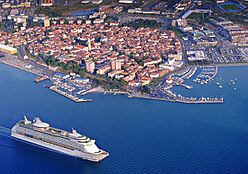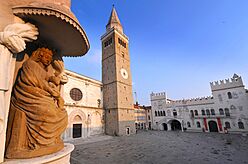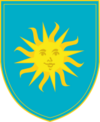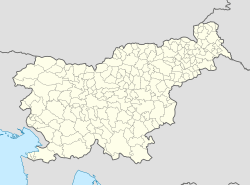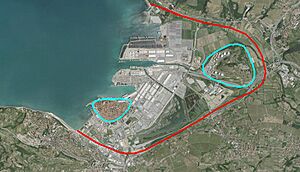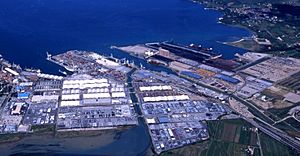Koper facts for kids
Quick facts for kids
Koper
Capodistria
|
|||
|---|---|---|---|
|
Town
|
|||
|
Koper from above
Loggia Palace
Da Ponte Fountain
Praetorian Palace
Port of Koper
Tito Square with the Praetorian Palace and Assumption Cathedral
|
|||
|
|||
| Country | |||
| Traditional region | Slovene Littoral | ||
| Statistical region | Coastal-Karst | ||
| Region | Slovene Istria | ||
| Municipality | City Municipality of Koper | ||
| Area | |||
| • Total | 13.0 km2 (5.0 sq mi) | ||
| Elevation | 3 m (10 ft) | ||
| Population
(2020)
|
|||
| • Total | 25,753 | ||
| • Rank | 5th | ||
| • Density | 1,981/km2 (5,131/sq mi) | ||
| Time zone | UTC+01 (CET) | ||
| • Summer (DST) | UTC+02 (CEST) | ||
| Postal code |
6000
|
||
| Area code(s) | +386 (0)5 | ||
| Vehicle registration | KP | ||
| Climate | Cfa | ||
Koper (which sounds like KO-per) is the fifth-largest city in Slovenia. It's located in the Istrian region, in the southwestern part of the country. Koper is the most important city on the Slovene coast.
The Port of Koper is Slovenia's only container port. It plays a huge role in the economy of the Municipality of Koper. Many Mediterranean cruise ships also visit Koper.
Koper is a main entry point into Slovenia from Italy by road. The main highway crossing is at Spodnje Škofije, north of the city. This highway continues into Italy towards Trieste. Koper also has a train connection to Ljubljana, the capital city.
Contents
Exploring Koper: Top Sights
Koper has many interesting places to visit. You can see the Praetorian Palace and the Loggia, both built in the 15th century. They show off a beautiful style called Venetian Gothic. There's also the 12th-century Carmine Rotunda church and St. Nazarius' Cathedral, which has a tower from the 14th century.
Praetorian Palace
Koper's Praetorian Palace from the 15th century is right on the city square. It was built by joining two older houses from the 13th century with a special covered walkway called a loggia. It was rebuilt many times and finally became the Venetian Gothic palace you see today. Now, it's home to Koper's tourist office.
Cathedral of the Assumption
The city's Cathedral of the Assumption was built in the second half of the 12th century. It has one of the oldest bells in all of Slovenia, made in 1333! You can sometimes go up to the top terrace for an amazing view of the Bay of Trieste. Inside, there's a famous painting from 1516 called the Sacra Conversatione, painted by Vittore Carpaccio. It's one of the best Renaissance paintings in Slovenia.
What's in a Name?
The Italian name for the city used to be Capo d'Istria. This means 'head of Istria'. You can find this name on old maps. In ancient times, the city was called Ægidia and Justinopolis.
Today, the city is also known as Croatian: Kopar in Croatian, Serbian: Копар, romanized: Kopar in Serbian, and German: Gafers in German. The people who speak Slovene call the city Koper. The Slovene name Koper was first written down in 1557, but it was spelled Copper back then.
A Look Back: Koper's History
Koper started as a small town on an island in the Gulf of Koper. The Romans called it Insula Caprea (Goat Island) or Capro. It grew into the city of Aegida, mentioned by the Roman writer Pliny the Elder.
In 568 AD, people from nearby Trieste moved to Aegida to escape invaders called the Lombards. The town was then renamed Justinopolis to honor the Byzantine Emperor Justinian II. Later, Koper was ruled by Lombards and Franks, and even briefly by Avars in the 8th century.
Koper has been an important religious center for a long time, with a diocese (a church district) since at least the 8th century.
Trade between Koper and Venice began as early as 932. Koper sided with the Holy Roman Empire in a war against Venice. Because of this, Emperor Conrad II gave Koper special town rights in 1035.
After 1232, Koper was under the Patriarch of Aquileia. In 1278, it became part of the Republic of Venice. At this time, some of the city walls were taken down. In 1420, Venice gained full control of Istria, making its power in Koper even stronger.
Koper became the capital of Venetian Istria and was renamed Caput Histriae, meaning 'head of Istria'. This is where its modern Italian name, Capodistria, comes from.
In the 16th century, Koper's population dropped a lot because of many plague outbreaks. It went from 10,000-12,000 people to much less. When Trieste became a free port in 1719, Koper lost its special trading rights, and its importance decreased even more.
After World War I, Koper became part of Italy. At the end of World War II, it was part of a special area called Zone B of the Free Territory of Trieste, controlled by Yugoslavia. Most Italian residents left the city by 1954. That's when Zone B officially became part of Socialist Federal Republic of Yugoslavia.
When Slovenia became independent in 1991, Koper's port became the only commercial port in Slovenia. The University of Primorska is also located in the city.
Koper's Climate
Koper has a humid subtropical climate (Cfa). This means it has hot, humid summers and mild winters. There's a good amount of rain throughout the year, even in the driest months. On average, each month gets more than 60 millimeters (2.4 inches) of rain.
The average temperature in Koper is about 14.4 degrees Celsius (57.9 degrees Fahrenheit). The city gets about 988 millimeters (38.9 inches) of rain each year.
| Climate data for Koper (1991–2020 normals, extremes 1950–2020) | |||||||||||||
|---|---|---|---|---|---|---|---|---|---|---|---|---|---|
| Month | Jan | Feb | Mar | Apr | May | Jun | Jul | Aug | Sep | Oct | Nov | Dec | Year |
| Record high °C (°F) | 18.0 (64.4) |
20.8 (69.4) |
24.3 (75.7) |
29.3 (84.7) |
33.0 (91.4) |
36.8 (98.2) |
37.6 (99.7) |
38.8 (101.8) |
33.5 (92.3) |
29.1 (84.4) |
24.9 (76.8) |
19.1 (66.4) |
38.8 (101.8) |
| Mean daily maximum °C (°F) | 9.2 (48.6) |
10.3 (50.5) |
14.2 (57.6) |
18.4 (65.1) |
23.1 (73.6) |
27.3 (81.1) |
29.7 (85.5) |
29.8 (85.6) |
25.0 (77.0) |
20.0 (68.0) |
14.8 (58.6) |
10.4 (50.7) |
19.3 (66.7) |
| Daily mean °C (°F) | 5.9 (42.6) |
6.5 (43.7) |
9.9 (49.8) |
13.8 (56.8) |
18.4 (65.1) |
22.7 (72.9) |
24.8 (76.6) |
24.6 (76.3) |
19.9 (67.8) |
15.4 (59.7) |
11.0 (51.8) |
7.1 (44.8) |
15.0 (59.0) |
| Mean daily minimum °C (°F) | 3.3 (37.9) |
3.6 (38.5) |
6.6 (43.9) |
10.1 (50.2) |
14.2 (57.6) |
18.1 (64.6) |
20.0 (68.0) |
20.2 (68.4) |
16.3 (61.3) |
12.3 (54.1) |
8.4 (47.1) |
4.4 (39.9) |
11.5 (52.7) |
| Record low °C (°F) | −9.8 (14.4) |
−12.7 (9.1) |
−7.0 (19.4) |
0.4 (32.7) |
3.7 (38.7) |
8.1 (46.6) |
10.1 (50.2) |
10.2 (50.4) |
5.9 (42.6) |
1.5 (34.7) |
−4.6 (23.7) |
−6.7 (19.9) |
−12.7 (9.1) |
| Average precipitation mm (inches) | 51 (2.0) |
58 (2.3) |
54 (2.1) |
63 (2.5) |
82 (3.2) |
91 (3.6) |
72 (2.8) |
71 (2.8) |
124 (4.9) |
121 (4.8) |
118 (4.6) |
84 (3.3) |
988 (38.9) |
| Average precipitation days (≥ 0.1 mm) | 10 | 8 | 8 | 11 | 12 | 10 | 8 | 8 | 10 | 11 | 13 | 10 | 121 |
| Source: Slovenian Environment Agency | |||||||||||||
People of Koper
In the past, Italian was the most common language spoken in Koper. However, after 1954, when Slovenian Istria became part of Yugoslavia, many ethnic Italians left the city.
Today, Koper is officially bilingual. Both Slovene and Italian are official languages. Most citizens speak Slovene, and Italian is mainly used as a second language. You can also find some people who speak Croatian.
Sports in Koper
The main soccer team in Koper is FC Koper. They play in the Slovenian PrvaLiga, which is the top soccer league in Slovenia. They have won the league championship once.
The Important Port of Koper
The Port of Koper has been important for the area's growth since the Roman Empire. It is one of the largest ports in the region. It's a key route for goods traveling from Asia to central Europe. Unlike many other European ports, the Port of Koper manages its own free trade zone, the port area, and acts as a terminal operator.
Famous People from Koper
Many interesting people have connections to Koper:
- Gian Rinaldo Carli (1720–1795), a writer.
- Vittore Carpaccio (around 1460–1525), a famous painter. He was born in Venice but lived in Koper.
- Vlatko Čančar (born 1997), a professional basketball player.
- Lucija Čok (born 1941), a linguist and politician.
- Zlatko Dedić (born 1984), a soccer player.
- Andreja Klepač (born 1986), a professional tennis player.
- Tinkara Kovač (born 1978), a singer.
- Santorio Santorio (1561–1636), a medical scientist.
- Damir Skomina (born 1976), a well-known football referee.
Sister Cities
Koper has special partnerships with other cities around the world. These are called twin towns or sister cities:
 Buzet, Croatia
Buzet, Croatia Ferrara, Italy
Ferrara, Italy Jiujiang, China
Jiujiang, China Muggia, Italy
Muggia, Italy San Dorligo della Valle, Italy
San Dorligo della Valle, Italy Žilina, Slovakia
Žilina, Slovakia
Images for kids
-
Josip Broz Tito and Haile Selassie in Koper in 1959
See also
 In Spanish: Koper para niños
In Spanish: Koper para niños


